Luofeng Jie
October 4th, 2011
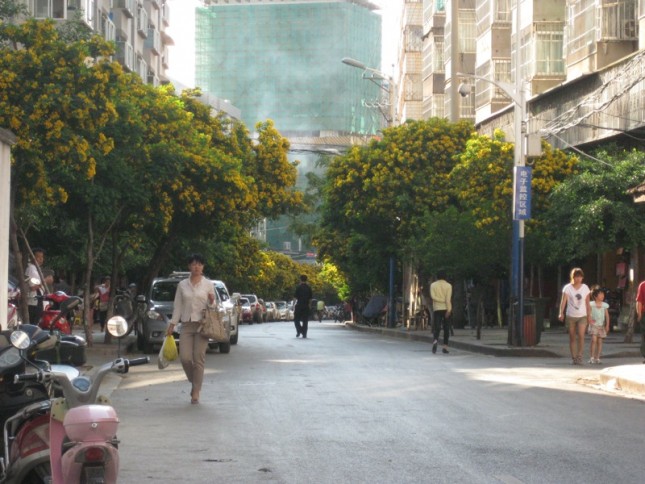
All summer long, the trees lining Luofeng Street have been covered in bright, golden flowers. The petals litter the red and green sidewalk tiles like confetti after a windstorm, and when it rains, bushels of the blossoms are pulled from their branches and rush down the street, creating a stream of golden whorls and eddies.
The street itself is quite narrow, just two lanes wide, and curves around from its originating point, at a large, seven lane intersection on Yuantong Street, to its finish, just a quarter of a mile away, where it makes a T with the even smaller street of Huashan Dong Lu. Beyond that, a small alleyway accessible only by foot or bicycle extends down the hill, giving one an indication of what all the streets around here must once have looked like.

When we first decided to live here, it was Luofeng Jie’s small, quiet character that appealed to us. Next to the mega-blocks and huge new construction projects in most of the city, this street has the feeling of a real neighborhood. In the morning, swarms of kids head to the elementary school in the middle of the block, many stopping to grab a bowl of noodles from one of the small, open-fronted restaurants on the way. A couple of regular street vendors appear, selling commuters on-the-go breakfasts like you tiao, a popular fried-dough snack, wrapped up in a tortilla-like pancake that has been heated over a charcoal grill and slathered with sweet bean sauce. Behind our apartment block, services start at the nearest Buddhist temple with an hour of chanting, accompanied by small drums and the occasional chime of tiny cymbals.
By late morning, the hairdressers, pharmacies, small clothing stores, and snack shops have opened and settled into their daily routines. The locksmith, working from a small cubbyhole across the street from us, plays cards with his friends while waiting for customers to come by. The tailors have their cloth samples hung up against the wall and go to work with their old-fashioned sewing machines, their feet pumping the pedals while they make the jackets and blouses displayed on the mannequins on the sidewalk. In the half-dozen tiny shops that sell an assortment of sodas, beer, ice cream bars, and cigarettes, shopkeepers play with their children or watch daytime television while they wait for the occasional customer. The waitresses and cooks at the various restaurants pull out their handwork and work on crochet or cross-stitch projects between meals. Along the side of the street leading up to the market, vendors from the countryside line up to sell seasonal fruit and vegetables arrayed on small cloths or piled in baskets.
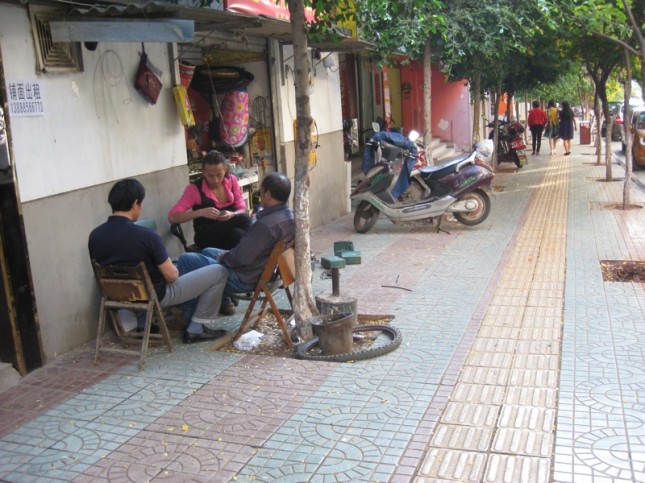
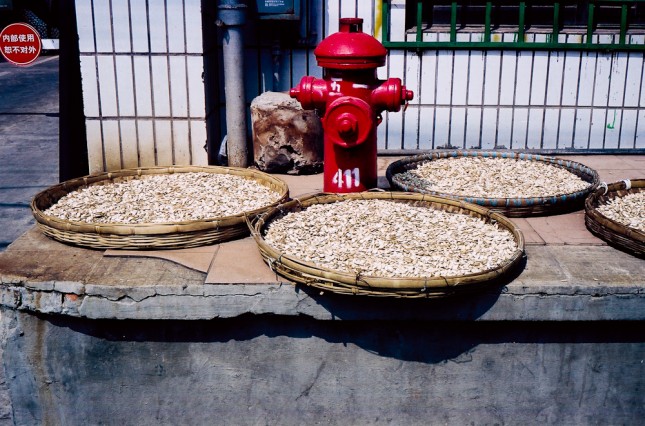
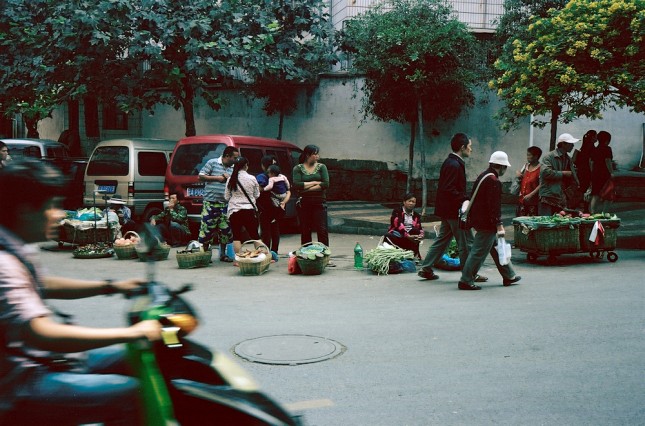

The biggest industry on the block, by far, is a branch of the Kunming Bakery Industry Association, but it is so thoroughly hidden behind other storefronts that you wouldn’t know it existed unless you saw the white-coated workers unloading bags of flour into a small loading dock or happed to be nearby when the smell of fresh baked goods envelops the block for a few minutes, making the neighborhood feel even quieter and sleepier than it already is.
There is a short burst of energy at lunch, when people gather in noodle shops, and again in the afternoon, when the kids come streaming out of school and cluster around the ice cream coolers and the vendors who come out to sell spiced, grilled tofu or frozen slushies made from coffee, cola, or juice. But the neighborhood’s only really busy time is in the evening, when people head out to restaurants with their friends, shopkeepers make dinner outside their front doors, and kids run around until late at night.
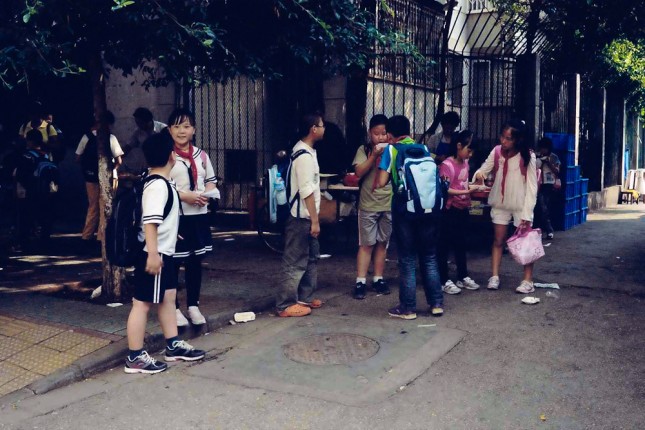

As the summer weeks passed, and we became more comfortable with our new environs, Josh and I developed our own daily routines and favorite spots. On the first night after we rented the apartment, before we’d even moved in, we discovered that the restaurant across the street, which serves Dai food, is some of the best food we’d had yet in Kunming. Every night the bamboo-fronted place is packed with customers, many of them spilling out onto tables set up on the sidewalk and in the narrow alley along the restaurant’s side. The teenage waitresses, all matching in their color-coordinated Thai-patterned skirts and bleached orange hair, serve southern Yunnanese dishes like stir-fried banana flower, pineapple rice, greens grilled in banana leafs, and soupy pork with pickles that have more in common with Thai food than Chinese.

At lunchtime, we opt for smaller meals and pop into our closest noodle shop, with its formica-covered picnic-style tables, or get a paper bag of jiang xiang bing, a doughy scallion pancake topped with a salty, savory bean paste, from a vendor in front of the market and take it back to the apartment with a glass of bubble milk tea or a bowl of mango-flavored pudding, topped with raisins and red beans, from the tea counter around the corner.
In the afternoons, on our way to do errands, we often join the locals in their ritual of a small ice cream bar as a snack. At first we simply visited the shop closest to our front gate for our sugar fix, but we soon discovered that next door there is another stand with a similar selection, sold by a young woman whose year-old daughter totters around on the shop’s steps or rides a plastic car up and down the sidewalk. After a few months, the girl has finally started returning our smiles when we pass, and we’ve begun to make a point of purchasing our ice cream and yogurt from her mother—a prerequisite, we feel, to making friends with the child. And in the evenings we head to the wet-market to shop alongside our neighbors for fresh ingredients for dinner or head down into the little walking alley for another bowl of noodles or a helping of meat and vegetables, skewered on sticks and grilled over an open fire, doused with a redolent mixture of salt, chili powder, and cumin.
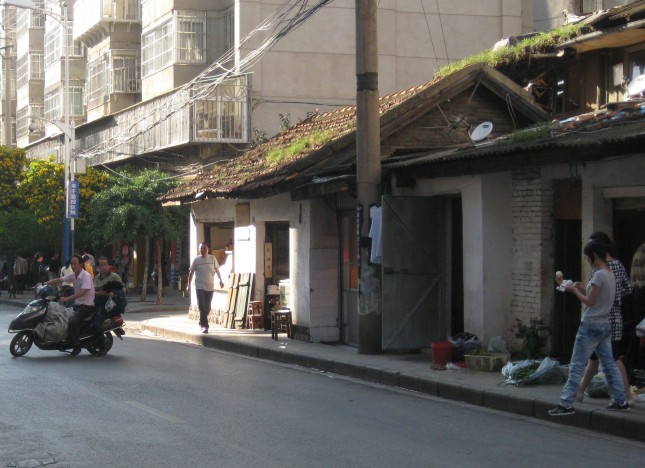
In the last couple weeks, however, autumn has finally caught up with us, and the lazy summer feeling of the street is quickly disappearing. The days have turned cool and rainy, the nights are getting to be quite cold, and our neighbors no longer linger outside for as long as they had just a few days ago. They hurry along a little faster now, slightly hunched over in their jackets, seemingly eager to get home. For our part, we’ve been hunkering down a little too, a little more hesitant to leave the house, especially in the mornings, when we have to put on wool sweaters and pull the cats onto our laps for warmth. But when we look out our window, Luofeng Jie still looks vibrant and cheery, because the cold hasn’t affected the flowers on the trees. For now, at least, they still line the street with their gold petals, looking even brighter in the rain and fog than they did in the sun.
Photos: Georgia Freedman (3), Josh Wand (6), Georgia Freedman



